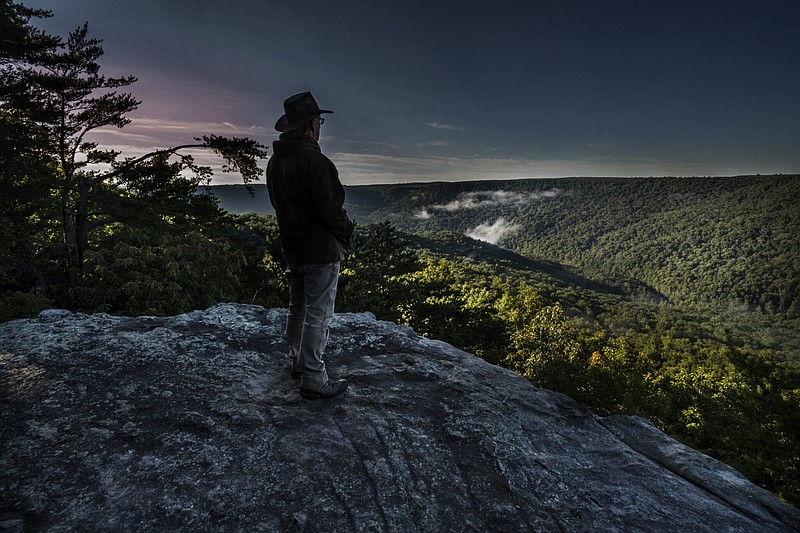Sneaking in clearcutting plans and other dubious forest management goals around the holidays and coldest winter months clearly is gaining in popularity with agencies charged with "conservation" protection - especially in Tennessee and Georgia.
Take for instance, the Tennessee Wildlife Resources Agency plan to raze 2,000 acres of old-growth hardwood trees on state-owned land in White County - ostensibly to create grassland habitat for the shrinking number of northern bobwhite quail, the official game bird of Tennessee, which thrives in savannas with sparse tree canopies.
Bear in mind that TWRA will profit from the sale of that hardwood timber, as it is the only state agency with the authority to retain the proceeds from the sale of the state's natural resources.
Bear in mind, also, that if TWRA's only aim in making such an enormous clearcut in the 16,000-acre Bridgestone Firestone Centennial Wilderness Area is to make suitable habitat for quail that hunters will then kill, why not instead clearcut some of the hundreds of acres of monoculture pine trees on that same Bridgestone wilderness map?
Local leaders are outraged by the current plan because it will spoil an area that has long served as an unspoiled wilderness adjacent to Fall Creek Falls State Park and Virgin Falls State Natural Area. They quickly add that it also will spoil the economic boon of Sparta and White County businesses that cater to tourists, hikers, kayakers and other visitors.
Those leaders also point out that the fast-growing pine trees are not native to the area but were introduced as paper pulp farms for an industry that no longer needs them. Use that area for quail savannas instead. And on Jan. 10, they had an attorney write a letter putting the state and TWRA on notice that the community will sue if the hardwood cutting plan is not halted.
This fight has been brewing since late last summer when a map of the plan showing 2,000 acres marked for deforestation was shown to a bird hunting group, Quail Forever. Word of it quickly spread to the community, which had been told when the land was gifted to the state that it would be preserved forever.
"I would never have dreamed TWRA would say, 'let's cut these trees and create an artificial savanna.' When were they going to tell us? We never would have known about any of this if it weren't for the leaked map," Sparta/White County Chamber of Commerce President Marvin Bullock told Tennessee Lookout.
TWRA tried to clean up by saying the map "hadn't been vetted" properly. The agency circulated a new map showing plans to cut 230 acres of hardwood forest in the "first phase" of establishing quail habitat in the wilderness area. But how many "phases" would there be? TWRA isn't telling.
Suffice it to say that TWRA's five-year strategic plan identifies the Bridgestone property as a "quail focal area" and notes that a minimum of 1,500 cleared acres is necessary in a quail focal area.
TWRA also scurried to obtain and announce in December (We mentioned dropping things on the public around the holidays, right?) that it had obtained outside legal counsel and been given the legal go-ahead, claiming the plan "meets the requirements" of the 1990s land gift to the state from the tire company. That gift came with certain strings attached, including that state officials "preserve the property predominantly in its present condition as a wilderness area."
TWRA calls this conservation.
"Speaking broadly as a conservation nonprofit, we have supported throughout our 75-year history the science-based, proactive management of lands to maintain or restore diverse habitats and diverse wildlife," Kate Hill, a Tennessee Wildlife Federation spokesperson, told the Tennessee Outlook via email. "The fact is, savannas are an endangered habitat in the Southeast that were once common and provided essential habitat to many species across Tennessee."
Bullock, the chamber and the community aren't backing down.
The TWRA plan "may harm numerous protected species in violation of the federal Endangered Species Act, according to the legal notice delivered to state wildlife officials and the Bridgestone company. TWRA has 60 days to find a better way or be sued, according to the letter.
Similarly, across the Tennessee state line to our south, the Southern Environmental Law Center, on behalf of four conservation groups, has filed a 25-page objection with the U.S. Forest Service's final environmental assessment released - you guessed it - just before November to "restore" 157,625 acres of Georgia's Conasauga, Blue Ridge and Chattooga River ranger districts in the Chattahoochee-Oconee National Forests.
The sweet-sounding "Foothills Landscape Project" would cut and market trees in patches on as much as 60,000 acres, perform prescribed burns on 50,000 acres, herbicide up to 74,500 acres and put 360 miles of new bulldozer paths for all that work in the Chattahoochee National Forest. The public has a little over a month to comment on the 206-page environmental assessment.
The SELC already has won some concessions in this project, which is roughly twice the size of Atlanta. The primary concession was in delaying it from the Christmas season of 2020, when the public had even less time between holidays to react.
But the environmental lawyers think that's still not enough.
Now the clock is ticking for both of these so-called "restoration" and "conservation" plans.
Lend your support to the real conservation groups fighting these false flag forestry plans.
